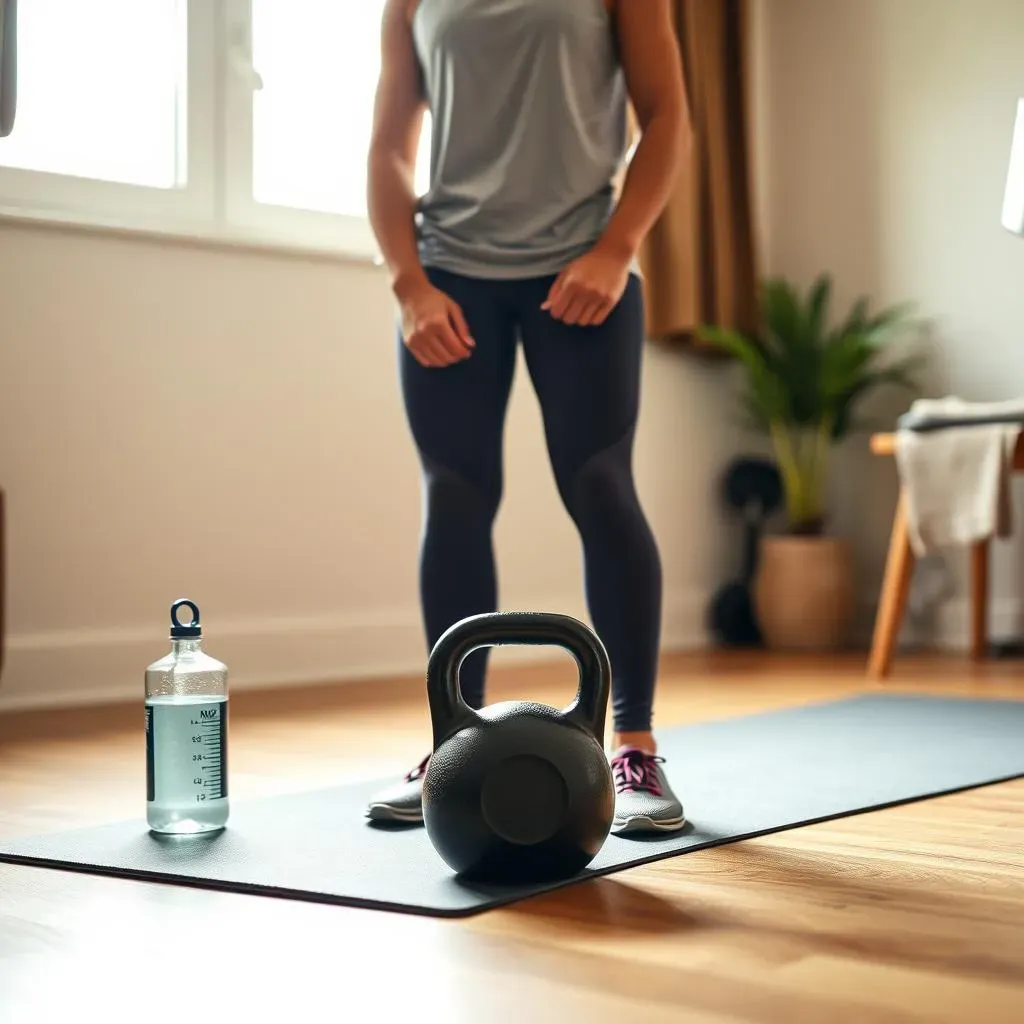Table of Contents
Ready to sculpt a stronger, more confident you? This guide is your all-access pass to the world of kettlebell training, even if you've never picked one up before! We'll break down everything you need to know to get started with a beginner kettlebell workout printable, making fitness fun and accessible. Forget complicated gym routines; we're focusing on simple, effective exercises you can do at home. Inside, you'll discover how to choose the right kettlebell weight for you, master essential exercises with clear instructions and illustrations, and find ready-to-use beginner kettlebell workout routines – all printable for easy access. We’ll also show you how to track your progress so you can see your strength grow. This isn't just about getting fit; it's about building a sustainable, enjoyable exercise habit. So grab your kettlebell (or find out which one to buy!), print out your workout plan, and let's embark on this fitness journey together! Let's get started with your "beginner kettlebell workout printable" journey.
Getting Started: Choosing Your Kettlebell and Setting Up

Getting Started: Choosing Your Kettlebell and Setting Up
Picking the Perfect Kettlebell
So, you're ready to start your kettlebell journey! Awesome! The first step is choosing the right kettlebell. Don't get overwhelmed; it's simpler than you think. For beginners, a lighter kettlebell is your best friend. We're talking 8-12 pounds (3.6-5.4 kg) for women, and 12-15 pounds (5.4-6.8 kg) for men. Think of it like this: you want to be able to perform the exercises with good form, not struggle through them. If you're unsure, start lighter and gradually increase the weight as you get stronger. You can always grab a heavier one later! For a more tailored plan, check out our best beginner kettlebell workout guide for more details.
Remember, proper form is key. It's better to use a lighter kettlebell and nail the technique than to injure yourself with a heavier one. We'll cover the essential exercises in detail later, but trust me, mastering the basics will make a huge difference in your results – and prevent injuries! If you're looking for a more comprehensive plan, you might find our 4-week kettlebell program helpful.
Gender | Recommended Starting Weight (lbs) | Recommended Starting Weight (kg) |
|---|---|---|
Women | 8-12 | 3.6-5.4 |
Men | 12-15 | 5.4-6.8 |
Setting Up Your Workout Space
You don't need a fancy gym to start your kettlebell workouts. A small, clear space is all you need. Make sure you have enough room to move freely without bumping into furniture or walls. Ideally, a carpeted area or a mat will help cushion your joints and provide better grip. A little bit of space is all you need to start your fitness journey. Check out our 10-minute beginner kettlebell workout to see how little space you need.
Having a water bottle nearby is essential. Staying hydrated is crucial during any workout, and kettlebell training is no exception. Also, consider having a towel handy to wipe away sweat – and maybe some upbeat music to keep you motivated! For a more intense workout, try our beginner kettlebell HIIT workout.
- Clear space (at least 6ft x 6ft)
- Workout mat (optional)
- Water bottle
- Towel
- Upbeat music (highly recommended!)
Safety First!
Before you start swinging that kettlebell like a pro (or even a beginner!), prioritize safety. Start slowly and focus on perfecting your form. If something feels off, stop and adjust. Don't be afraid to take breaks when you need them. Listen to your body, and don't push yourself too hard, especially when you're starting. Remember, consistency is key to seeing results; you're better off with short, regular sessions than infrequent marathon workouts. For a short routine, check out our 15-minute beginner kettlebell workout.
If you have any pre-existing conditions or injuries, it's always a good idea to consult your doctor or a physical therapist before starting any new workout program. They can help you create a safe and effective plan that aligns with your individual needs and capabilities. And remember: your fitness journey is personal to you. Take your time, and enjoy the process! For a full body workout, check out our beginner kettlebell full body workout.
Essential Kettlebell Exercises for Beginners

Essential Kettlebell Exercises for Beginners
Kettlebell Swings: The Foundation
Let's talk kettlebell swings – the king of beginner exercises! It's a full-body movement that builds strength and endurance like crazy. Think of it as a dynamic squat with a swing. You'll feel it in your legs, glutes, and core. The key is to hinge at your hips, keeping your back straight and your core engaged. Don't just fling the kettlebell; use your legs to generate power. For a more focused swing workout, check out our beginner kettlebell swing workout.
Start with lighter weight and focus on proper form. It's tempting to go heavy, but trust me, mastering the technique is more important. Once you've got it down, you can gradually increase the weight and reps. For a more comprehensive approach, our 5 basic kettlebell exercises guide will be really helpful.
- Stand with feet shoulder-width apart.
- Hinge at hips, keeping back straight.
- Swing kettlebell between legs, then up to chest height.
- Control the movement, avoiding jerky motions.
Goblet Squats: A Classic with a Twist
Next up: goblet squats! Hold the kettlebell close to your chest, like a goblet. Squat down as if sitting in a chair, keeping your back straight and your chest up. The kettlebell helps with balance and adds some extra weight to challenge your legs and glutes. It's a fantastic exercise for building lower body strength. Want a workout that focuses on your legs? Try our beginner kettlebell leg workout.
Remember to keep your knees aligned with your toes to avoid injury. Go slow and controlled, focusing on the feeling in your legs. As you get stronger, you can increase the weight or reps. For a full-body routine incorporating squats, see our beginner kettlebell full body workout.
Exercise | Sets | Reps | Rest |
|---|---|---|---|
Goblet Squats | 3 | 10-12 | 60 seconds |
Kettlebell Rows: Building Upper Body Strength
Now let's work on your back and biceps with kettlebell rows. This exercise is great for building upper body strength and improving posture. Hinge at the hips, keeping your back straight. Grab the kettlebell with one hand, letting it hang down. Pull the kettlebell up towards your chest, squeezing your shoulder blades together. Lower it back down slowly and repeat. For a more focused arm workout, check out our beginner kettlebell arm workout.
Maintain a flat back throughout the movement; don't round your spine. Control the weight as you lift and lower, focusing on the muscles in your back. For a full body routine, our full body kettlebell workout for beginners is a good option.
Sample Beginner Kettlebell Workout Routines (Printable!)

Sample Beginner Kettlebell Workout Routines (Printable!)
Workout Routine 1: The 20-Minute Blast
This workout is perfect for beginners who are short on time but still want to get a great workout. It focuses on compound movements to maximize calorie burn and muscle engagement. Remember to focus on proper form over speed or weight. You can adjust the reps based on your fitness level. For a similar workout, check out our 20-minute kettlebell workout for beginners.
Don't forget to warm up before starting! Five minutes of light cardio and dynamic stretching will prepare your body for the workout and help prevent injuries. After the workout, cool down with some static stretching, holding each stretch for 30 seconds. For a more comprehensive warm-up routine, check out our beginner kettlebell workout guide.
Exercise | Sets | Reps | Rest |
|---|---|---|---|
Kettlebell Swings | 3 | 15 | 30 seconds |
Goblet Squats | 3 | 10 | 30 seconds |
Kettlebell Rows (each side) | 3 | 10 | 30 seconds |
Workout Routine 2: The Full-Body Flow
This routine is designed to work your entire body, targeting different muscle groups in a flowing sequence. It incorporates a variety of exercises to challenge your strength, endurance, and coordination. Remember to listen to your body and take rest when needed. For a similar full-body routine, check out our beginner full-body kettlebell workout.
This workout is best performed 2-3 times per week, with rest days in between. As you get stronger, you can increase the weight, reps, or sets, or try adding another round to the circuit. A consistent schedule is key to seeing results. Want a structured plan? Check out our 4-week kettlebell program.
- Warm-up (5 minutes)
- Kettlebell Swings (3 sets of 15 reps)
- Goblet Squats (3 sets of 10 reps)
- Kettlebell Rows (3 sets of 10 reps per side)
- Overhead Press (3 sets of 8 reps per side)
- Cool-down (5 minutes)
Tracking Your Progress and Avoiding Common Mistakes

Tracking Your Progress and Avoiding Common Mistakes
Keeping Track: A Simple Progress Tracker
So you're crushing those kettlebell workouts – awesome! But how do you know you're actually getting stronger? Tracking your progress is key to staying motivated and seeing real results. A simple notebook or spreadsheet can do wonders. Note down the exercises you do, the weight you use, the number of sets and reps, and how you felt during the workout. Were you tired? Did you feel strong? Did you nail your form perfectly? Tracking these details will help you see patterns and make adjustments. For a printable tracker, check out our beginner kettlebell workout PDF which includes a handy progress tracker.
Don't just focus on the numbers; pay attention to how your body feels. Are you getting stronger? Do you feel more energized throughout the day? Do your clothes fit differently? These are all signs of progress, even if the numbers on the page don't change dramatically each week. For a structured approach, consider our 4-week kettlebell program which includes a built-in progress tracker.
- Record exercises performed
- Note weight used
- Track sets and reps
- Log how you felt during each workout
Common Mistakes to Avoid: Form Over Force
One of the biggest mistakes beginners make is prioritizing weight over form. It's tempting to lift heavier, but poor form can lead to injuries and prevent you from seeing results. Focus on mastering the technique of each exercise before increasing the weight. Watch videos, practice in front of a mirror, or even better, work with a trainer if you can. This will save you from injuries and frustration down the road. Check out our 5 basic kettlebell exercises guide for detailed form instructions.
Another common mistake is neglecting rest and recovery. Your muscles need time to repair and rebuild after a workout. Make sure you're getting enough sleep, eating a balanced diet, and taking rest days between workouts. Don't push yourself too hard, especially when you are starting. Consistency is key, not intensity. For a shorter, less intense routine, try our 10-minute beginner kettlebell workout.
Mistake | Solution |
|---|---|
Poor form | Prioritize technique over weight |
Insufficient rest | Allow ample recovery time |
Listen to Your Body: Rest and Recovery
Finally, and this is crucial: listen to your body. If something hurts, stop. Don't push through pain. Rest is just as important as exercise. Your body needs time to recover and rebuild. If you're feeling overly sore or fatigued, take a rest day or two. Don't be afraid to modify exercises or reduce the weight if you need to. Remember, progress is not linear – there will be ups and downs! For a gentler approach, check out our kettlebell workouts for female beginners.
Consistency is far more important than intensity. Short, regular workouts are better than infrequent marathon sessions. Aim for consistency over intensity. Remember, progress is a journey, not a race. Celebrate your wins along the way, no matter how small. For a balanced approach, try our beginner kettlebell full-body workout.